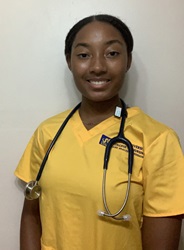Student Spotlight: Deanna Telesford
September 28, 2020
 From the time Deanna Telesford was in middle school, she knew that she wanted to be a nurse and a teacher. With an interest in helping others, she focused her college search on programs that offered her direct entry into a nursing program and that would give her the best preparation for her career. She discovered Drexel’s College of Nursing and Health Professions through her neighbor who attends Drexel, and she decided to apply and ultimately to attend. As a third-year student, who selected the four-year, one co-op program, Telesford will have the opportunity to work for six months during her current academic year in a field of her choice. She is interested in working as a pediatric nurse practitioner in the future as well as exploring alternative fields within healthcare.
From the time Deanna Telesford was in middle school, she knew that she wanted to be a nurse and a teacher. With an interest in helping others, she focused her college search on programs that offered her direct entry into a nursing program and that would give her the best preparation for her career. She discovered Drexel’s College of Nursing and Health Professions through her neighbor who attends Drexel, and she decided to apply and ultimately to attend. As a third-year student, who selected the four-year, one co-op program, Telesford will have the opportunity to work for six months during her current academic year in a field of her choice. She is interested in working as a pediatric nurse practitioner in the future as well as exploring alternative fields within healthcare.
The Co-op program at Drexel is a hallmark of the educational experience, and an aspect of the curriculum that resonated with Telesford. Co-op allows students to learn and work alongside experts in their fields, giving them direct experience and empowering them to be leaders. Through an exploration process, students select their top jobs through the Steinbright Career Development Center, which often leads to interviews. Telesford is interested in several opportunities for her co-op in the fall quarter and has pursued a position as a medical assistant.
An engaged student on campus, Telesford looked into a variety of student groups and clubs in her first year, and over time became more focused on the Drexel Dance Ensemble. As a high school dancer and gymnast, Deanna was eager to continue these activities at Drexel. The Drexel Dance Ensemble is a professional caliber dance company presenting two fully produced concerts each year. Students participating in the 50-member ensemble explore their artistry through working with professional choreographers, both faculty and guest artists, as well as a selection of student choreographers. The ensemble performs contemporary and classical dance forms. 
Drexel nurses also spend meaningful time in simulation labs throughout their program. There are two primary simulation labs that students engage with: the Standardized Patient Encounters, which has been designed to simulate a provider’s office with all necessary healthcare equipment, where highly-trained standardized patients, or actors playing the role of patients, allow students to develop clinical skills; and the Human Patient Simulation Lab, where the use of computerized human patient simulators, standardized patients or hybrid cases are used for skill building. The space can be transformed into acute (ICU, OR, ER, medical surgical, or women’s health) or community (home, board room, community center) environments.
Telesford began her clinical courses in her sophomore year in the Human Patient Simulation Lab, where she was paired with another nursing student to manage a scenario presented by the faculty. In her lab, there were numerous opportunities to practice new skills, especially around responding to emergency situations. Students enter these scenarios, which are unknown, and offered basic information about the situation, followed by their entry into the room and responsibility for the plan of care. While situations can be stressful, Telesford relied on expert preparation and faculty feedback, which was shared in a way that empowers nursing students.